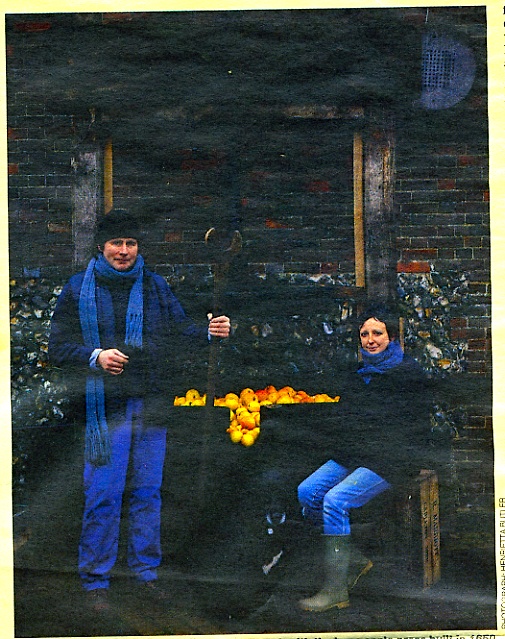East
of
Eden
On a pressing engagement in Norfolk, Chris Arnot gets a real taste of traditional skills

To the Spanner born: Ryan and Diana Burnet , with the the huge apple press built in 1650.
Ryan is a serious artist who has exhibited in London and Norwich. But, for the past three years, he has had no time for drawing or painting. His life has been taken over by cider.
He and his wife, Diana, are helping to reverse a nationwide trend by making about 8,000 gallons a year on traditional presses. No apple concentrates. No additives. No modern technology (apart from a machine to mill the apples).
The Burnards sell straight from the barrel at their shop opposite Banham Zoo. "The Cidery" is part of a rather twee development of converted farm buildings. Craft shops, a bakery and a bistro are clustered around a small fountain in what is now known as The Apple Yard.
"When we first came here, this building housed two goats and a llama," said Diana. That was in 1987. They had decided that East Anglia would be more congenial than the East End of London to bring up their young sons, Alex and Hugo. Ryan was also attracted by the light and the landscapes, while Diana could carry on working as a freelance storyboard artist and send her drawings up to London by train. And both have long been partial to cider. Ryan was born in Cornwall and went to art college in Bristol, where he acquired a taste for the stuff at a legendary pub called the Coronation Tap. Later, he learnt how to make it while helping a small producer on the banks of the River Severn.
It was a pure coincidence that their quest for rural tranquillity led the Burnards to Banham where orchards are plentiful and the Norfolk cider industry thrived until the last century. Gaymers started there before moving closer to the railway at nearby Attleborough.
Many smaller family businesses went into decline during this century. Old presses were abandoned in barns and back yards, and Ryan unearthed his first press in a 40-acre wood yard. He was already making a small amount of cider for home consumption, with the help of a car jack but here was a chance to use the right tool for the job, even if the wood was rotten to the core. While he was inspecting it, the heavy metal part detached itself from its surround and came crashing down on the base. He wouldn't have been the first West Countryman to lose his head to cider, but, thankfully, he pulled it away in time to avoid decapitation.
It took him two months to restore the press, using "great chunks of oak" from the wood yard. Soon he and Diana were selling cider from their smallholding, tucked away down a lane behind the zoo. But the Banham Cider label was in the possession of the zoo owner, Martin Goymour. (Goymours and Gaymers abound in this part of the world). Would he be prepared to let them have it?
He would. He could also offer them the the chance to rent the shop in his new development. They've been there ever since, attracting a steady trickle of visitors from across the road. After the monkey sanctuary, the cider sampling.
Glasses are available to taste the goods before making a decision. Perhaps the Banham Strong (8.4 per cent alcohol and dry, without being sharp), or the medium dry Old Hardie (8.2 per cent). Then there's the Extra Dry (7.6 per cent) or the type stored in rum barrels which have imparted something of their own flavour. Sweeter varieties are available for those who want them. Prices range from £1.90 to £2.40 a litre.
All the ciders are as pale and clear as white wines, with the exception of the Rough, which is young and still working and hence slightly cloudy. The paleness comes from the apples used - Bramleys, Cox and Spartan from local orchards. There's none of the tannin contained in cider apples.
Such is the steady growth in demand that the Burnards now have four presses, including one recently imported from E Somerset and weighing in at nearly four tons. Built in 1650, it's about 15-foot high, with a surround of gnarled elm, and looks like an ancient instrument of torture, a great brute-of a thing. But in Ryan's eyes it's "lovely". He would like to be able to have it at the centre of an extension where customers could eat and drink while watching cider being made.
It's a project very much in the long-term. 9Rather like his chances of getting back to drawing and painting.